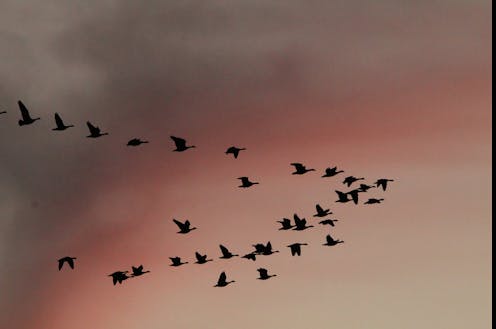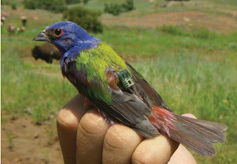Birds migrate along ancient routes – here are the latest high-tech tools scientists are using to stu
Satellite telemetry, tiny geolocation tags and passive acoustic recording are providing new insights into bird migration and vital data for conservation.

Although it still feels like beach weather across much of North America, billions of birds have started taking wing for one of nature’s great spectacles: fall migration. Birds fly south from the northern U.S. and Canada to wintering grounds in the southern U.S., Caribbean and Latin America, sometimes covering thousands of miles. Other birds leave temperate Eurasia for Africa, tropical Asia or Australia.
Using observation records and data collected through bird banding, 20th-century ornithologists roughly mapped general migration routes and timing for most migratory species. Later, using radar at airports and weather stations, they discovered how weather and other factors affect when birds migrate and how high they fly.
Today, technological advances are providing new insights into bird migration and showing that it is more complex and wonderful than scientists ever imagined. These new and constantly improving technologies are key aids for protecting migratory birds in the face of habitat loss and other threats.
Birding across borders
The power of the internet has greatly aided migratory bird research. Using the popular eBird network, birders all over the world can upload sightings to a central database, creating a real-time record of the ebb and flow of migration. Ornithologists have also learned to use NEXRAD, a national network of Doppler weather radars, to visualize birds migrating down the North American continent.
Now, scientists are setting up a global network of receiver stations called the Motus Network, which currently has 1,500 receivers in 31 countries. Each receiver constantly records the presence of any birds or other animals within a nine-mile (15-kilometer) radius that scientists have fitted with small, lightweight radio transmitters, and shares the data online. The network will become increasingly useful for understanding bird migration as more receiver stations become active along migration tracks.
Tracking individual birds via satellite
Three new technologies are rapidly expanding what we know about bird migration. The first is satellite telemetry of bird movement. Researchers fit birds with small solar-powered transmitters, which send data on the birds’ locations to a satellite and then on to a scientist’s office computer. The scientist can learn where a bird is, the route it took to get there and how fast it travels.
For example, the bar-tailed godwit, a pigeon-sized shorebird, breeds in Alaska and then migrates to New Zealand. Satellite transmitters show that godwits often fly nonstop from Alaska to New Zealand. Recently, a godwit set the record for the longest nonstop flight by a land bird: 8,100 miles (13,000 kilometers) in 10 days, from Alaska to Australia.
Satellite telemetry studies show how much individual birds, even those from the same breeding location, vary in their migratory behavior. Individual differences in migratory behavior are probably due to differences in physical condition, learning, experience and personal preferences.
Another shorebird, the whimbrel, also makes a phenomenally long journey over the ocean. Satellite telemetry has shown that some whimbrels travel from northwest Canada, across the North American continent to Canada’s east coast, then set off over the Atlantic Ocean on a 3,400-mile (5,400-kilometer), six-day nonstop flight to the coast of Brazil. In total, they may travel 6,800 miles (11,000 kilometers).
Sadly, hunters kill some of these birds when they land to rest on islands in the Lesser Antilles. The unfortunate fate of two satellite-tracked whimbrels has catalyzed a campaign to tighten regulations on shorebird hunting in the Caribbean.
Geotagging small birds
Many birds are too small to carry a satellite transmitter. Given the energetic effort required for migration, a device must weigh less than 5% of a bird’s body weight, and many migratory songbirds weigh under 0.7 ounces (20 grams).
An ingenious solution for small birds is a geolocator tag, or geologger – a tiny device that simply records time, location and presence or absence of sunlight. Scientists know the timing of sunrise and sunset on a given date, so they can calculate a bird’s location on that date to within about 125 miles (200 kilometers).

Birds carrying geologgers must be recaptured to download the data. That means the bird must survive a migration round trip and return to the same place where it was first captured and tagged. Amazingly, many geologger-tagged small birds do.
Geologgers have shown that Blackpoll warblers – small songbirds that breed in the boreal forests of North America – fly long distances over the Atlantic in fall, heading to the Amazon basin. Birds breeding in eastern North America head out over the Atlantic in maritime Canada or the northeastern U.S. and make a 60-hour, nonstop, 1,500-mile (2,500-kilometer) flight to the Greater Antilles. There they rest and recuperate, then continue across the Caribbean to South America.
Blackpolls breeding in Alaska fly across the North American continent before leaving shore on the Atlantic coast and flying to South America. In total, they journey 6,600 miles (10,700 kilometers) over 60 days.
Even more amazing, geologgers show that another small songbird, the northern wheatear, migrates from North America to sub-Saharan Africa. Wheatears that breed in Alaska fly 9,100 miles (14,600 kilometers) across Asia to East Africa, taking three months to do so. Those breeding in eastern Canada journey 4,600 miles (7,400 kilometers) across the Atlantic to Europe and then on to West Africa – including a 2,100-mile (3,400-kilometer), four-day nonstop overwater flight.
Recording birds’ night migration calls
Two hours after sunset in fall, I like to sit outside and listen to birds migrating overhead. Most birds migrate at night, and many give a species-specific “chit,” “zeep” or other call-note while in flight. The calls may serve to keep migrating flocks together, including different species heading to the same destination.
Ornithologists are using automated passive acoustic recording to study these nocturnal calls and identify the species or group of related species that make each sound. The technology is a microphone directed at the sky, connected to a computer that continuously records the sound stream and is aided by sound recognition software. Sometimes it reveals migrants overhead that are rarely seen on the ground.
Nick Kachala, an honors student in my lab, set up recording units on three university properties in the fall of 2021. One of the most common migrants recorded was the gray-cheeked thrush, a shy bird of the northern boreal forest that is rarely seen in the northeast U.S. during fall migration. He also detected the dickcissel, a grassland bird that I have never seen in our area.
Many birdwatchers are now building do-it-yourself backyard recording units to identify the birds flying over their homes during migration.
Conserving migratory birds
Radar monitoring indicates that the number of North American migratory birds declined by 14% between 2007 and 2017. There probably are multiple causes, but habitat loss is likely the principal culprit.
Satellite telemetry and geologgers show that there are special stopover sites along migration routes where migrants rest and refuel, such as the Texas Gulf Coast, the Florida Panhandle and Mexico’s Yucatan Peninsula. Conservation experts widely agree that to protect migratory birds, it is critical to conserve these sites.
Effective conservation measures require knowing where and how birds migrate, and what dangers they face during migration. Ornithologists, using these new technologies, are learning things that will help to stop and reverse the global decline in migratory birds.
Tom Langen ne travaille pas, ne conseille pas, ne possède pas de parts, ne reçoit pas de fonds d'une organisation qui pourrait tirer profit de cet article, et n'a déclaré aucune autre affiliation que son organisme de recherche.
Read These Next
How the ‘slayer rule’ might play a role in determining who will inherit wealth from Rob Reiner and h
These rules have a long history in the United States. They played a role in the notorious murders by…
As DOJ begins to release Epstein files, his many victims deserve more attention than the powerful me
Powerful men connected to Jeffrey Epstein are named, dissected and speculated about. The survivors,…
The world risks forgetting one of humanity’s greatest triumphs as polio nears global eradication − 7
Polio may finally be defeated in the next 5 years. Will the world recognize what an extraordinary achievement…






